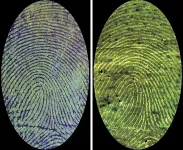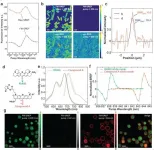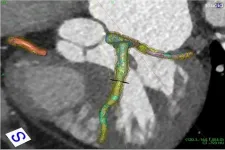(Press-News.org) Careful criminals usually clean a scene, wiping away visible blood and fingerprints. However, prints made with trace amounts of blood, invisible to the naked eye, could remain. Dyes can detect these hidden prints, but the dyes don't work well on certain surfaces. Now, researchers reporting in ACS Applied Materials & Interfaces have developed a fluorescent polymer that binds to blood in a fingerprint -- without damaging any DNA also on the surface -- to create high-contrast images.
Fingerprints are critical pieces of forensic evidence because their whorls, loops and arches are unique to each person, and these patterns don't change as people age. When violent crimes are committed, a culprit's fingerprints inked in blood can be hard to see, especially if they tried to clean the scene. So, scientists usually use dyes to reveal this type of evidence, but some of them require complex techniques to develop the images, and busy backgrounds can complicate the analysis. In addition, some textured surfaces, such as wood, pose challenges for an identification. Fluorescent compounds can enhance the contrast between fingerprints and the surface on which they are deposited. However, to get a good and stable image, these molecules need to form strong bonds with molecules in the blood. So, Li-Juan Fan, Rongliang Ma and colleagues wanted to find a simple way to bind a fluorescent polymer to blood proteins so that they could detect clear fingerprints on many different surfaces.
The researchers modified a yellow-green fluorescent polymer they had previously developed by adding a second amino group, which allowed stable bonds to form between the polymer and blood serum albumin proteins. They dissolved the polymer and absorbed it into a cotton pad, which was placed on top of prints made with chicken blood on various surfaces, such as aluminum foil, multicolored plastic and painted wood. After a few minutes, they peeled off the pad, and then let it air-dry. All of the surfaces showed high contrast between the blood and background under blue-violet light and revealed details, including ridge endings, short ridges, whorls and sweat pores. These intricate patterns were distinguishable when the researchers contaminated the prints with mold and dust, and they lasted for at least 600 days in storage. In another set of experiments, a piece of human DNA remained intact after being mixed with the polymer, suggesting that any genetic material found after processing a print could still be analyzed to further identify a suspect, the researchers say.
INFORMATION:
The authors acknowledge funding from Yao Liu, academician of the Chinese Academy of Engineering; the Major Basic Research Project of the Natural Science Foundation of the Jiangsu Higher Education Institutions of China; the Priority Academic Program Development of Jiangsu Higher Education Institutions; and the National Key Technologies R&D Program of China.
The abstract that accompanies this paper can be viewed here.
The American Chemical Society (ACS) is a nonprofit organization chartered by the U.S. Congress. ACS' mission is to advance the broader chemistry enterprise and its practitioners for the benefit of Earth and all its people. The Society is a global leader in promoting excellence in science education and providing access to chemistry-related information and research through its multiple research solutions, peer-reviewed journals, scientific conferences, eBooks and weekly news periodical Chemical & Engineering News. ACS journals are among the most cited, most trusted and most read within the scientific literature; however, ACS itself does not conduct chemical research. As a specialist in scientific information solutions (including SciFinder® and STN®), its CAS division powers global research, discovery and innovation. ACS' main offices are in Washington, D.C., and Columbus, Ohio.
To automatically receive news releases from the American Chemical Society, contact newsroom@acs.org.
Follow us: Twitter | Facebook
Water touches virtually every aspect of human society, and all life on earth requires it. Yet, fresh, clean water is becoming increasingly scarce -- one in eight people on the planet lack access to clean water. Drivers of freshwater salt pollution such as de-icers on roads and parking lots, water softeners, and wastewater and industrial discharges further threaten freshwater ecosystem health and human water security.
"Inland freshwater salt pollution is rising nationwide and worldwide, and we investigated the potential conflict between managing freshwater salt ...
Screening for a sometimes fatal condition among patients with a rare autoimmune disease could soon - thanks to a computer algorithm - become even more accurate.
Researchers at Michigan Medicine found that an internet application improved their ability to spot pulmonary arterial hypertension in patients with systemic sclerosis, or scleroderma. The unpredictable condition is marked by tightening of the skin that can damage internal organs.
The algorithm, aptly named DETECT, outperformed standard methods used to identify the form of high blood pressure in the lungs that causes the heart to weaken and fail.
"We've been advocating for a long time that every scleroderma patient should be screened on an annual basis using DETECT, and ...
BETHESDA, Md. -- The COVID-19 pandemic heavily influenced spending on prescription drugs in the U.S. in 2020, according to the ASHP's (American Society of Health-System Pharmacists) National Trends in Prescription Drug Expenditures and Projections for 2021. Shifts in care related to the pandemic will continue to be a significant driver of drug expenditures in 2021, along with uptake in the use of biosimilars, a large pipeline of new cancer drugs, and increased approvals of specialty medications.
Prescription drug spending in 2020 grew at a moderate rate of 4.9% to $535.3 billion. Increased utilization drove the ...
Published in the Advanced Functional Materials, University of Minnesota researcher Hongbo Pang led a cross-institutional study on improving the efficacy of nucleotide-based drugs against prostate cancer and bone metastasis.
In this study, Pang and his research team looked at whether liposomes, when integrated with the iRGD peptide, will help concentrate antisense oligonucleotides (ASOs) into primary prostate tumors and its bone metastases. Liposomes are used as a drug carrier system, and ASOs are a type of nucleotide drug.
More importantly, they investigated whether this system ...
DUARTE, Calif. -- Scientists at City of Hope, a world-renowned independent research and treatment center for cancer and diabetes, have developed a novel, noninvasive liquid biopsy test for detecting lymph node metastasis in individuals with high-risk T1 colorectal carcinoma. Research on the development of the blood test was reported in a END ...
A new study is the first-ever to identify the genes for creativity in Homo sapiens that distinguish modern humans from chimpanzees and Neanderthals. The research identified 267 genes that are found only in modern humans and likely play an important role in the evolution of the behavioral characteristics that set apart Homo sapiens, including creativity, self-awareness, cooperativeness, and healthy longevity. The study, led by an international and interdisciplinary team of researchers from the American Museum of Natural History and Washington University among other institutions, is published today in the journal Molecular Psychiatry.
"One of the most fundamental questions about ...
It has been a long pursuit to develop super-resolution imaging techniques for Raman microscopy, which has intrinsic advantages of chemical specificity over the fluorescence counterpart. Despite the perceived importance and extensive research efforts, true super-resolution (defined as diffraction-unlimited) Raman imaging of biological systems in the optical far-field remains challenging due to the deficiency in sensitivity for conventional Raman scattering. Consequently, those reported super-resolution vibrational imaging methods have to base on excitation saturating, ...
The Endangered dryas monkey (Cercopithecus dryas), endemic to the Democratic Republic of the Congo, is one of Africa's most mysterious primates. The discovery of the dryas monkey killed by a hunter in the buffer zone of Lomami National Park in 2014 has prompted field research of this small species (5-7 pounds). However, they are difficult to detect because they live in dense vegetation in secondary forest thickets.
Using non-invasive research and no-flash camera traps from 2014 to 2019, scientists from Florida Atlantic University in collaboration with researchers from the FZS-Lomami Project, Democratic Republic of the Congo, now have picture-perfect details on this elusive species. They have confirmed ...
Astronomers have discovered a pulsar--a dense and rapidly spinning neutron star sending radio waves into the cosmos--using a low-frequency radio telescope in outback Australia.
The pulsar was detected with the Murchison Widefield Array (MWA) telescope, in Western Australia's remote Mid West region.
It's the first time scientists have discovered a pulsar with the MWA but they believe it will be the first of many.
The finding is a sign of things to come from the multi-billion-dollar Square Kilometre Array (SKA) telescope. The MWA is a precursor telescope for the SKA.
Nick Swainston, a PhD student at the Curtin University node of the International Centre for Radio Astronomy Research (ICRAR), made the discovery while processing data collected as part ...
Coronary artery disease (CAD) is the most common form of heart disease and is present in about END ...







